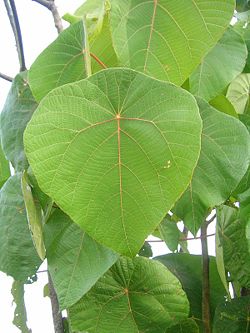- Macaranga
-
Macaranga 
Macaranga tanarius Scientific classification Kingdom: Plantae (unranked): Angiosperms (unranked): Eudicots (unranked): Rosids Order: Malpighiales Family: Euphorbiaceae Subfamily: Acalyphoideae Tribe: Acalypheae Subtribe: Macaranginae Genus: Macaranga
ThouarsSpecies 300+, see text
Macaranga is a large genus of Old World tropical trees of the family Euphorbiaceae and the only genus in the subtribe Macaranginae. Native to Africa, Australasia, Asia and the South Pacific, the genus comprises over 300 different species. These plants are noted for being recolonizers. Macaranga species are used as food plants by the larvae of some Lepidoptera species including Endoclita malabaricus. Macaranga species often form symbioses with ant (Formicidae) species (particularly Crematogaster ants of the subgenus Decacrema) because they have hollow stems that can serve as nesting space and occasionally provide nectar. The trees benefit because the ants attack herbivorous insects and either drive them away or feed on them.[1]
Contents
Use
Macaranga Gum, a crimson resin is obtained from Macaranga indica.
Synonymy
- Adenoceras Rchb.f. & Zoll. ex Baill.
- Mappa A.Juss
- Mecostylis Kurz ex Teijsm. & Binn.
- Pachystemon Blume
- Panopia Noronha ex Thouars
- Phocea Seem.
- Tanarius Kuntze
- Vatta, known as in Kerala.
Species include
- Macaranga acerifolia
- Macaranga aenigmatica
- Macaranga allorobinsonii
- Macaranga attenuata
- Macaranga beccariana
- Macaranga beillei
- Macaranga bicolor
- Macaranga capensis
- Macaranga caudatifolia
- Macaranga celebica
- Macaranga congestiflora
- Macaranga conglomerata
- Macaranga conifera
- Macaranga crassistipulosa
- Macaranga gigantea
- Macaranga grandifolia
- Macaranga hispida
- Macaranga huahineensis
- Macaranga indica
- Macaranga involucrata
- Macaranga loheri
- Macaranga mappa
- Macaranga mauritiana
- Macaranga minahassae
- Macaranga paxii
- Macaranga peltata
- Macaranga puncticulata
- Macaranga quadricornis
- Macaranga raivavaeensis
- Macaranga rorokae
- Macaranga sandsii
- Macaranga serratifolia
- Macaranga sinensis
- Macaranga taitensis
- Macaranga tanarius
- Macaranga triloba
- Macaranga venosa
- Macaranga waturandangii
References
- ^ Federle, W.; Maschwitz, U.; Fiala, B. (1998). "The two-partner ant-plant system of Camponotus (Colobopsis) sp. 1 and Macaranga puncticulata (Euphorbiaceae): Natural history of the exceptional ant partner". Insectes Sociaux 45 (1): 1–16. doi:10.1007/s000400050064.
Categories:
Wikimedia Foundation. 2010.

